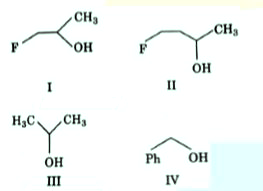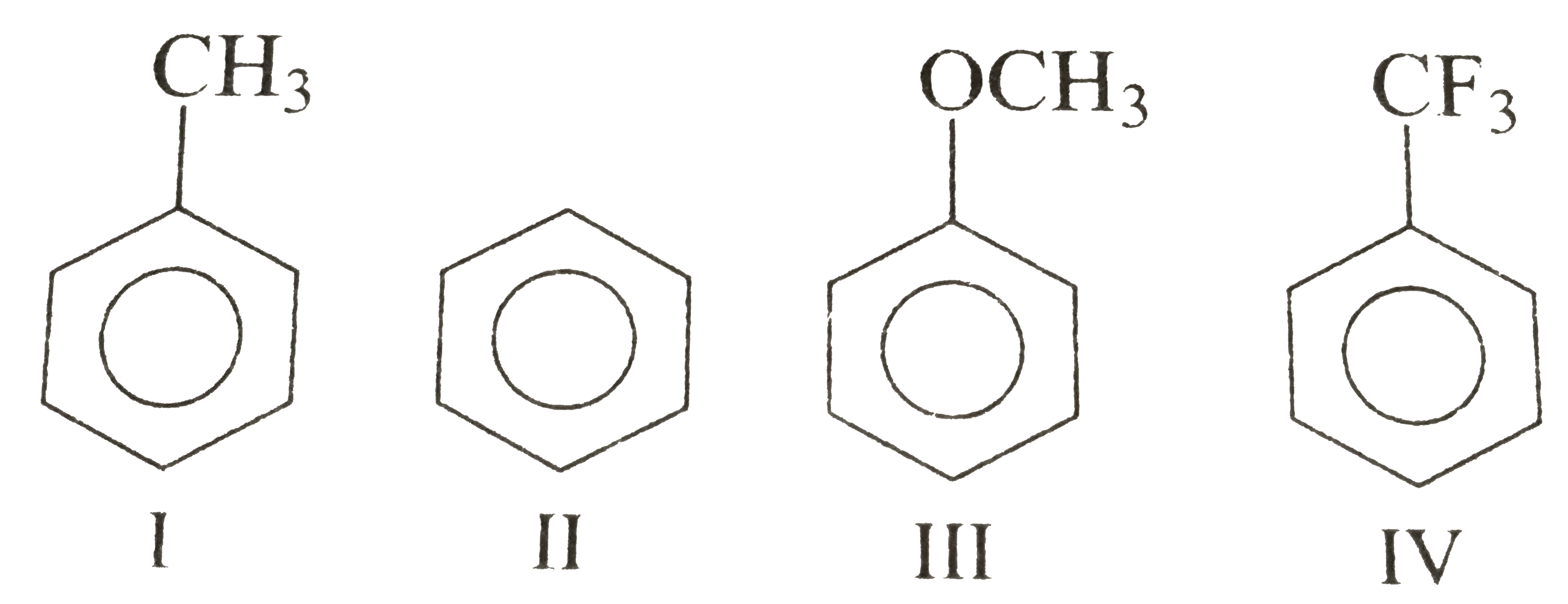Arrange in the order of decreasing relavtive reactivity with an electrophile and explain Toluene, p - Nitrotoluene, 1, 4 - Dinitrobenzene
To determine the order of decreasing relative reactivity with an electrophile for toluene, para-nitrotoluene, and 1,4-dinitrobenzene, we need to analyze the effects of the substituents on the benzene ring.
1. Identify the Compounds:
- Toluene (C6H5CH3) has a methyl group (-CH3) attached to the benzene ring.
- Para-nitrotoluene (C6H4(NO2)CH3) has a nitro group (-NO2) at the para position relative to the methyl group.
- 1,4-Dinitrobenzene (C6H4(NO2)2) has two nitro groups at the 1 and 4 positions.
2. Understand Electrophilic Aromatic Substitution:
- In electrophilic aromatic substitution, the benzene ring acts as a nucleophile due to its electron-rich nature.
- The reactivity of the benzene ring towards electrophiles depends on the electron-donating or electron-withdrawing effects of the substituents.
3. Analyze the Effects of Substituents:
- Toluene: The methyl group (-CH3) is an electron-donating group through the +I (inductive) effect. This increases the electron density on the benzene ring, making it more reactive towards electrophiles.
- Para-nitrotoluene: The nitro group (-NO2) is a strong electron-withdrawing group through both -R (resonance) and -I (inductive) effects. The presence of the nitro group decreases the electron density on the ring, making it less reactive than toluene.
- 1,4-Dinitrobenzene: With two nitro groups, the electron-withdrawing effect is even stronger, significantly reducing the electron density on the benzene ring. This makes 1,4-dinitrobenzene the least reactive towards electrophiles.
4. Order of Reactivity:
- Based on the above analysis, we can arrange the compounds in order of decreasing reactivity with an electrophile:
- Most Reactive: Toluene (due to +I effect of -CH3)
- Moderately Reactive: Para-nitrotoluene (due to -R and -I effects of -NO2)
- Least Reactive: 1,4-Dinitrobenzene (due to strong -R and -I effects of two -NO2 groups)
Final Order:
Toluene > Para-nitrotoluene > 1,4-Dinitrobenzene
---
- Toluene (C6H5CH3) has a methyl group (-CH3) attached to the benzene ring.
- Para-nitrotoluene (C6H4(NO2)CH3) has a nitro group (-NO2) at the para position relative to the methyl group.
- 1,4-Dinitrobenzene (C6H4(NO2)2) has two nitro groups at the 1 and 4 positions.
- In electrophilic aromatic substitution, the benzene ring acts as a nucleophile due to its electron-rich nature.
- The reactivity of the benzene ring towards electrophiles depends on the electron-donating or electron-withdrawing effects of the substituents.
- Toluene: The methyl group (-CH3) is an electron-donating group through the +I (inductive) effect. This increases the electron density on the benzene ring, making it more reactive towards electrophiles.
- Para-nitrotoluene: The nitro group (-NO2) is a strong electron-withdrawing group through both -R (resonance) and -I (inductive) effects. The presence of the nitro group decreases the electron density on the ring, making it less reactive than toluene.
- 1,4-Dinitrobenzene: With two nitro groups, the electron-withdrawing effect is even stronger, significantly reducing the electron density on the benzene ring. This makes 1,4-dinitrobenzene the least reactive towards electrophiles.
- Based on the above analysis, we can arrange the compounds in order of decreasing reactivity with an electrophile:
- Most Reactive: Toluene (due to +I effect of -CH3)
- Moderately Reactive: Para-nitrotoluene (due to -R and -I effects of -NO2)
- Least Reactive: 1,4-Dinitrobenzene (due to strong -R and -I effects of two -NO2 groups)
Toluene > Para-nitrotoluene > 1,4-Dinitrobenzene
Topper's Solved these Questions
- BOOK - CBSE COMPLEMENTARY MATERIALCHAPTER - HYDROCARBONSEXERCISE - 5- MARK QUESTION13videos
HYDROCARBONS
- BOOK - CBSE COMPLEMENTARY MATERIALCHAPTER - HYDROCARBONSEXERCISE - UNIT TEST16videos
HYDROCARBONS
- BOOK - CBSE COMPLEMENTARY MATERIALCHAPTER - HYDROCARBONSEXERCISE - 2- MARK QUESTION28videos
HYDROCARBONS
- BOOK - CBSE COMPLEMENTARY MATERIALCHAPTER - EQUILIBRIUM EXERCISE - UNIT TEST6videos
EQUILIBRIUM
- BOOK - CBSE COMPLEMENTARY MATERIALCHAPTER - HYDROGENEXERCISE - Unit Test11videos
HYDROGEN
Similar Questions
Arrange the following in decreasing order of their reactivity with an electrophile.
 View Solution
View SolutionArrange the following set of compounds in order of their decreasing relative reactivity with an electrophile, E+
(a) Chlorobenzene, 2,4-dinitrochlorobenzene, p-nitrochlorobenzene
(b) Toluene, p−H3C–C6H4–NO2,p−O2N–C6H4–NO2.View Solution
Knowledge Check
- Question 1 - Select One
Arrange these in correct order of decreasing reactivity
 AI>II>III>IVBI>III>II>IVCIV>III>II>IDIV>III>I>II
AI>II>III>IVBI>III>II>IVCIV>III>II>IDIV>III>I>II - Question 2 - Select One
Arrange these in correct order of decreasing reactivity.
 AI>II>III>IVBI>III>II>IVCIV>III>II>IDIV>III>I>II
AI>II>III>IVBI>III>II>IVCIV>III>II>IDIV>III>I>II - Question 3 - Select One
Arrange the following set of compounds in the order of their decreasing relative reactivity with an electrophileE+
I.Chlorobenzene
II.2,4 dinitrochlorobenzene
III.P-nitrochlorobenzene
IV.toluene V.p−H3C−C6H4−NO2AI>II>III>IV>VBIV>V>I>III>IICV>IV>III>II>IDI>III>II>V>IV
Arrange the following set of compounds in order of their decreasing relative reactivity with an electrophile, E+.
(i) chlorobenzene, 2,4−dinitrochlorobenzene, p−nitrochloro benzene
(ii) toluene, p−H3C−C6H4−CH3,p−H3C−C6H4−NO2,p−O2N−C6H4−NO2View SolutionArrange the following set of compounds in order of their decreasing relative reactivity with an electrophile, E+
(a) Chlorobenzene, 2,4-dinitrochlorobenzene, p-nitrochlorobenzene
(b) Toluene, p−H3C–C6H4–NO2,p−O2N–C6H4–NO2.View SolutionAmong the compounds the order of decreasing reactivity towards electrophilic substance is :
 View Solution
View SolutionArrange the following set of compounds in the order of their decreasing relative reactivity with an electrophile
 View Solution
View SolutionArrange the following set of compounds in the order of their decreasing relative reactivity with an electrophile
 View Solution
View Solution
